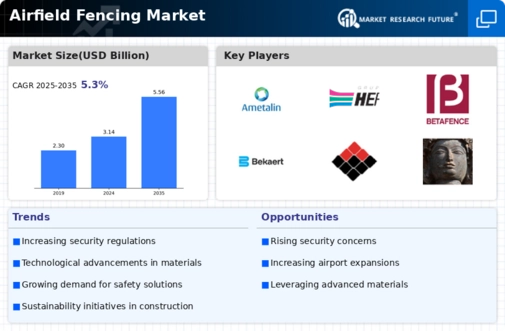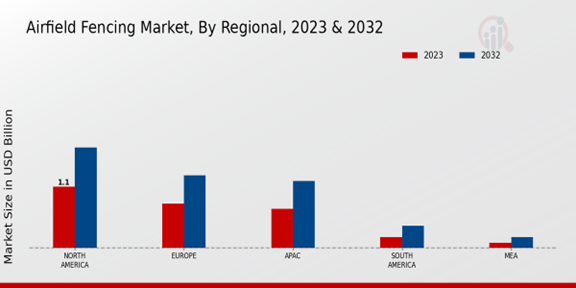Increasing Global Air Traffic
The Global Airfield Fencing Market Industry is experiencing growth driven by the rising global air traffic. As more passengers and cargo are transported via air, the demand for enhanced security measures at airports intensifies. In 2024, the market is projected to reach 3.14 USD Billion, reflecting the need for robust fencing solutions to secure airfields. Airports are increasingly investing in advanced fencing technologies to mitigate security risks associated with increased traffic. This trend is likely to continue, as the International Air Transport Association forecasts a steady rise in air travel, further propelling the need for effective airfield fencing solutions.
Market Trends and Projections
The Global Airfield Fencing Market Industry is characterized by several key trends and projections. The market is anticipated to grow from 3.14 USD Billion in 2024 to 5.56 USD Billion by 2035, indicating a robust demand for airfield fencing solutions. The compound annual growth rate of 5.33% from 2025 to 2035 suggests a sustained expansion in this sector. Factors such as increasing air traffic, regulatory compliance, and technological advancements are driving this growth. The market is likely to evolve, with new innovations and solutions emerging to meet the changing security landscape.
Growing Awareness of Security Risks
The Global Airfield Fencing Market Industry is witnessing growth due to the increasing awareness of security risks associated with air travel. Recent incidents have highlighted vulnerabilities at airports, prompting stakeholders to prioritize security enhancements. This heightened awareness is leading to greater investments in fencing solutions that provide a secure perimeter around airfields. As airport operators recognize the potential consequences of security breaches, the demand for reliable fencing systems is expected to rise. This trend underscores the critical role of airfield fencing in safeguarding airport operations and ensuring passenger safety.
Rising Investment in Airport Infrastructure
The Global Airfield Fencing Market Industry is benefitting from rising investments in airport infrastructure globally. Governments and private entities are allocating substantial funds to upgrade and expand airport facilities, which includes enhancing security measures. This trend is particularly evident in emerging economies, where airport modernization projects are underway. The increased focus on infrastructure development is expected to drive the demand for effective airfield fencing solutions. As a result, the market is poised for growth, with projections indicating a significant increase in value over the next decade, reflecting the importance of security in airport development.
Regulatory Compliance and Security Standards
The Global Airfield Fencing Market Industry is significantly influenced by stringent regulatory compliance and security standards imposed by aviation authorities. Governments worldwide are mandating enhanced security measures to protect airports from potential threats. This regulatory landscape compels airport operators to invest in high-quality fencing solutions that meet or exceed these standards. As a result, the market is expected to grow, with projections indicating a value of 5.56 USD Billion by 2035. Compliance with regulations not only ensures safety but also fosters public confidence in air travel, further driving the demand for advanced fencing systems.
Technological Advancements in Fencing Solutions
Technological advancements are reshaping the Global Airfield Fencing Market Industry, as innovative materials and designs enhance security and durability. The introduction of smart fencing solutions, such as integrated surveillance systems and motion sensors, is becoming increasingly prevalent. These technologies provide real-time monitoring and rapid response capabilities, which are crucial for maintaining airport security. The market is likely to witness a compound annual growth rate of 5.33% from 2025 to 2035, as airports seek to adopt these advanced solutions to address evolving security challenges. This trend indicates a shift towards more proactive security measures in airfield fencing.










